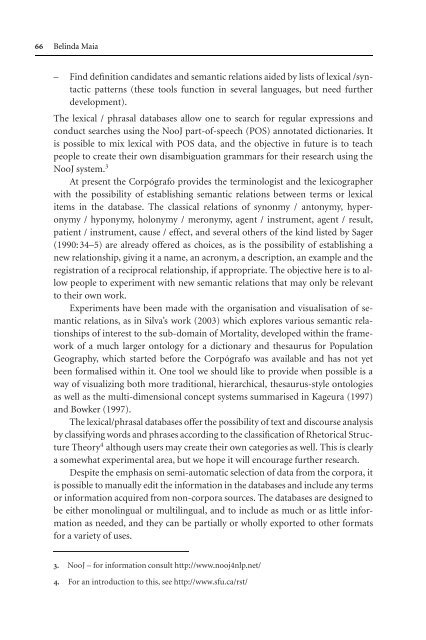Topics in Language Resources for Translation ... - ymerleksi - home
Topics in Language Resources for Translation ... - ymerleksi - home
Topics in Language Resources for Translation ... - ymerleksi - home
- No tags were found...
Create successful ePaper yourself
Turn your PDF publications into a flip-book with our unique Google optimized e-Paper software.
66 Bel<strong>in</strong>da Maia– F<strong>in</strong>d def<strong>in</strong>ition candidates and semantic relations aided by lists of lexical /syntacticpatterns (these tools function <strong>in</strong> several languages, but need furtherdevelopment).The lexical / phrasal databases allow one to search <strong>for</strong> regular expressions andconduct searches us<strong>in</strong>g the NooJ part-of-speech (POS) annotated dictionaries. Itis possible to mix lexical with POS data, and the objective <strong>in</strong> future is to teachpeople to create their own disambiguation grammars <strong>for</strong> their research us<strong>in</strong>g theNooJ system. 3At present the Corpógrafo provides the term<strong>in</strong>ologist and the lexicographerwith the possibility of establish<strong>in</strong>g semantic relations between terms or lexicalitems <strong>in</strong> the database. The classical relations of synonmy / antonymy, hyperonymy/ hyponymy, holonymy / meronymy, agent / <strong>in</strong>strument, agent / result,patient / <strong>in</strong>strument, cause / effect, and several others of the k<strong>in</strong>d listed by Sager(1990:34–5) are already offered as choices, as is the possibility of establish<strong>in</strong>g anew relationship, giv<strong>in</strong>g it a name, an acronym, a description, an example and theregistration of a reciprocal relationship, if appropriate. The objective here is to allowpeople to experiment with new semantic relations that may only be relevantto their own work.Experiments have been made with the organisation and visualisation of semanticrelations, as <strong>in</strong> Silva’s work (2003) which explores various semantic relationshipsof <strong>in</strong>terest to the sub-doma<strong>in</strong> of Mortality, developed with<strong>in</strong> the frameworkof a much larger ontology <strong>for</strong> a dictionary and thesaurus <strong>for</strong> PopulationGeography, which started be<strong>for</strong>e the Corpógrafo was available and has not yetbeen <strong>for</strong>malised with<strong>in</strong> it. One tool we should like to provide when possible is away of visualiz<strong>in</strong>g both more traditional, hierarchical, thesaurus-style ontologiesas well as the multi-dimensional concept systems summarised <strong>in</strong> Kageura (1997)and Bowker (1997).The lexical/phrasal databases offer the possibility of text and discourse analysisby classify<strong>in</strong>g words and phrases accord<strong>in</strong>g to the classification of Rhetorical StructureTheory 4 although users may create their own categories as well. This is clearlya somewhat experimental area, but we hope it will encourage further research.Despite the emphasis on semi-automatic selection of data from the corpora, itis possible to manually edit the <strong>in</strong><strong>for</strong>mation <strong>in</strong> the databases and <strong>in</strong>clude any termsor <strong>in</strong><strong>for</strong>mation acquired from non-corpora sources. The databases are designed tobe either monol<strong>in</strong>gual or multil<strong>in</strong>gual, and to <strong>in</strong>clude as much or as little <strong>in</strong><strong>for</strong>mationas needed, and they can be partially or wholly exported to other <strong>for</strong>mats<strong>for</strong> a variety of uses.3. NooJ – <strong>for</strong> <strong>in</strong><strong>for</strong>mation consult http://www.nooj4nlp.net/4. For an <strong>in</strong>troduction to this, see http://www.sfu.ca/rst/
















